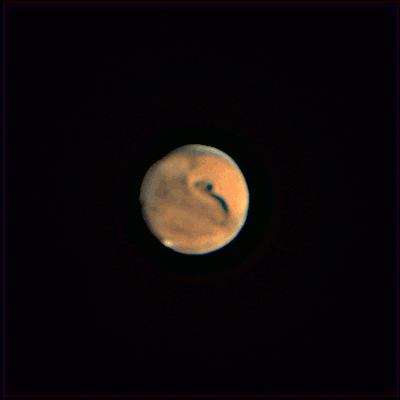Amateur Astrophotography
Skywatcher Skymax Maksutov-Cassegrain f = 1500mm / D=127mm F12 SynScan AZ GOTO
Skywatcher Skyhawk Newtonian f= 500mm (450mm) / D=114mm F4
Skywatcher Explorer 130PDS Newtonian, f=650mm / D=130mm F5 with Skywatcher Mount EQ5 Pro SynScan GoTo
Mars, the red planet is very bright, which means easy to take higher quality videos with huge number of frames per second. And it is getting higher in sky! Opposition happens at October 13. Good! We are going to analyze the only thing visible, its albedo. Some regions of mars look darker and some look brighter. Planetary scientists say that albedo has little relation to topography. The bright areas are now known to be locations where fine dust covers the surface. The dark areas are places where the wind has swept clean of dust, leaving behind dark, rocky material.
September 22 20h 33min UTC. You can see a wonderful image showing Mars atmosphere (notice the difference between the left and right side of the planet). The Sun is illuminating the planet from the left side. Also notice the differences between the north and south hemispheres. Of course you can see the iced south pole. Wonderful!
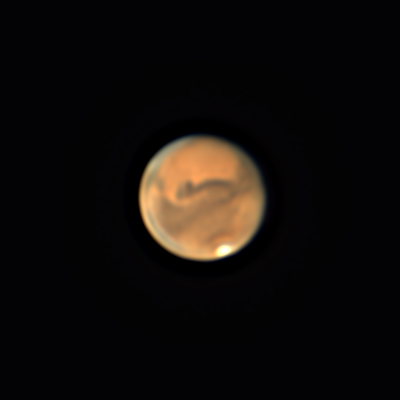
Please watch 23 minuts of evolution of Mars in the sky:
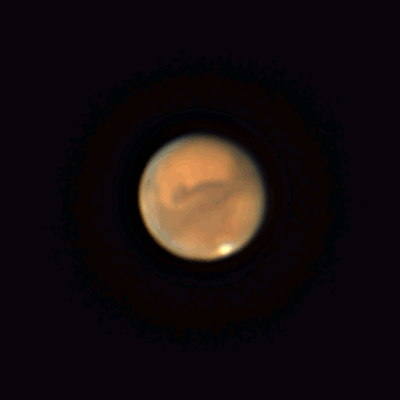
September 30, 22h 09min UTC. We capture this wonderful image of Mars, stacking with Autostakkert and processing it first with Fitswork and then with GIMP. Notice that this corresponds to the east side of the images taken on 21st September, so we are making a full map of Mars step by step:
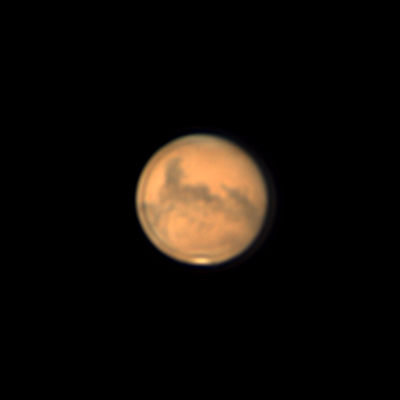
We also processed this image using Registax and GIMP:
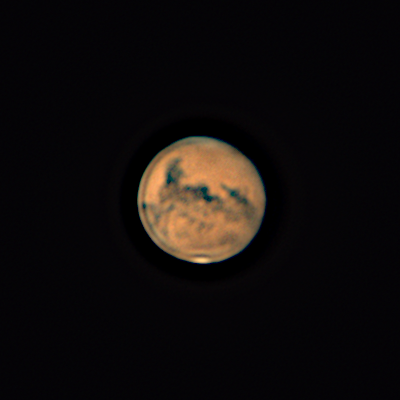
We can see that fitswork allow to get detail obtaining a more natural image. However Registax wavelets seems to get a bit more detail at the cost of getting a very strong contrast. I still have to learn a lot about both, but little by little I like fitswork better.
It follows an animated gif showing the rotation of the planet. It corresponds to an interval of 52 minutes starting at 21:46 UTC.
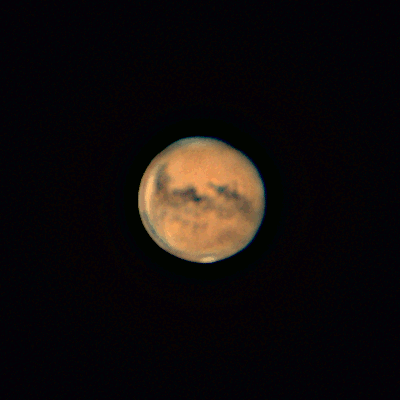
October 5, 22h 08min UTC. We obtain this image of Mars, stacking with Autostakkert and processing it first with Fitswork and then with GIMP. Notice that this corresponds to the east side of the images taken on September 30, so we continue our mapping of Mars:
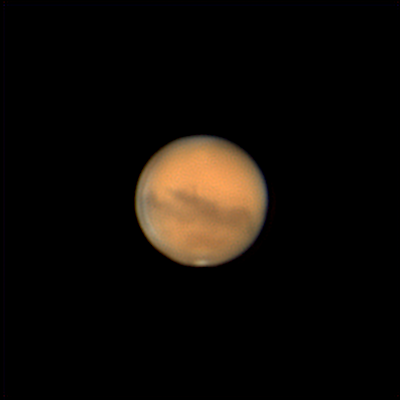
October 9, 21h 39min UTC. We obtain this image of Mars, processing only with GIMP. Notice that this corresponds to the east side of the images taken on October 5. We can see a light orange round region in the northern hemisphere, in the east side of the image. It is not clear whether this is a region in the surface or some kind of clouds. Given the color, it seems it belongs to the surface (may be related to Olympus Mons). On the west side, more or less at the same latitude, another spot is visible (probably Elysium mons). Near the equatorial region, also in the east side, we can see clearly a nearly white line of clouds.
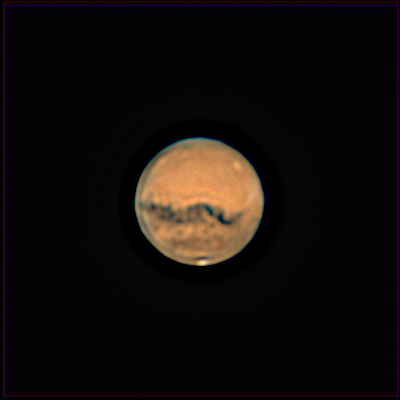
We can see both spots clearly in the following image at 22h 33min UTC:
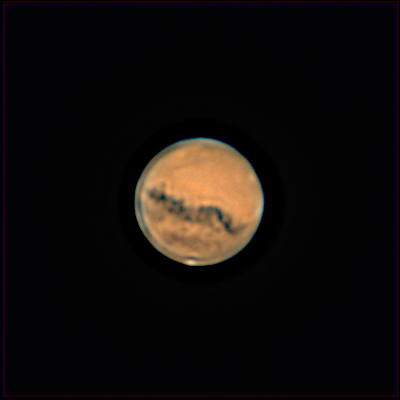
An animation follows, corresponding to a time span of 1 hour, from 21:32 UTC.
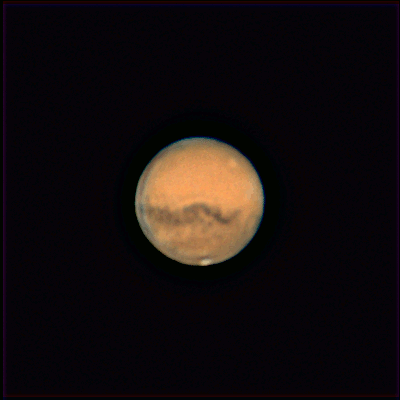
October 17. We continue to get new images of Mars. Look at the following one, taken at 21h 55min UTC
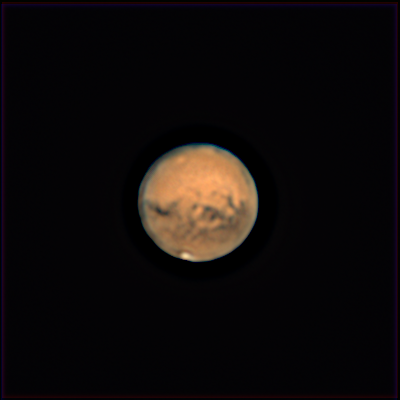
and this one taken at 22h 39min UTC
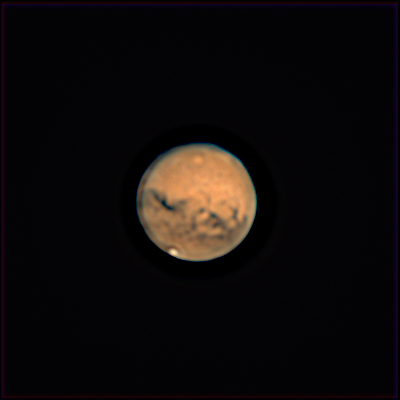
Clearly the west side of the planet corresponds to the east side of the images taken on October 9, so we are getting close to get a full map of Mars. We can see now "Olympus Mons" very clearly as a light orange region. It is interesting to notice that in the northern hemisphere, the images look "noisy". But looking at a series of images, we realize that the noise corresponds to real features of mars surface. Taking a look to the following animated gif, it becomes obvious. It starts at 21h 35min and it lasts one hour and 22 minutes:
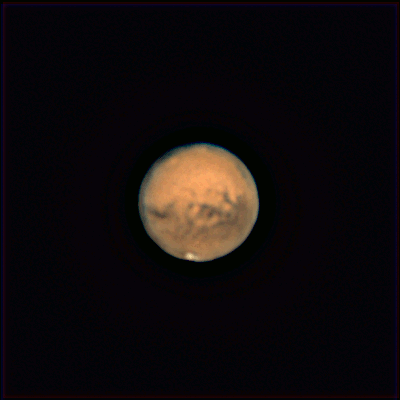
October 18, 21h 49min UTC, I get this wonderful picture. Mare Acidalium is starting to show up in the east side:
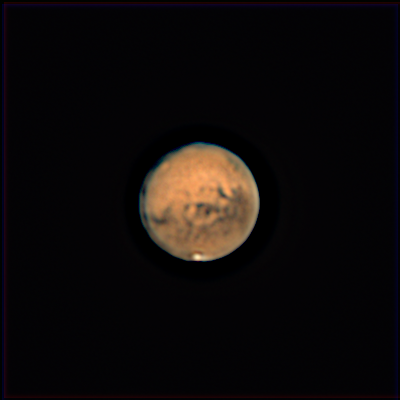
October 29th, 23:47 UTC, another wonderful picture with plenty of detail. Notice in the west side some bluish regions corresponding to clouds. On the east side, some very faint red lines, starting near the south pole and going to the north, can be seen. Those are not artifacts, and they can be seen in different images rotating together with the planet. The northern darker region corresponds to Mare Acidalium. The southernmost feature from Mare Acidalium is called "Oxia Palus" (it seems a peninsula of Mare Acidalium), and looks bluish, may be because of the presence of clouds. Some other dark areas look cyan. All this stuff is easier to see from the images looking at them at 200% size.
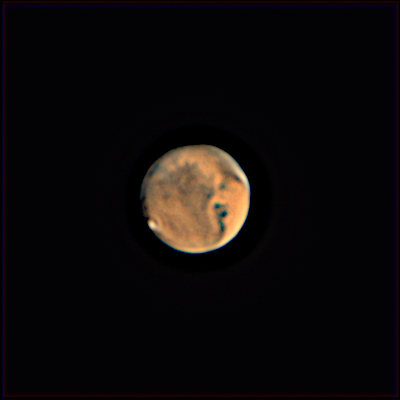
Taking a look to the following animated gif, in the last images we can see those mysterious red lines rotating with the planet. It can only be seen in the last images because the seeing was quite good only by the end of the session, when mars was higher in the sky. It starts at 22h 11min and it lasts and finishes at 23h 54min minutes, so about one hour and 45 minuts:
